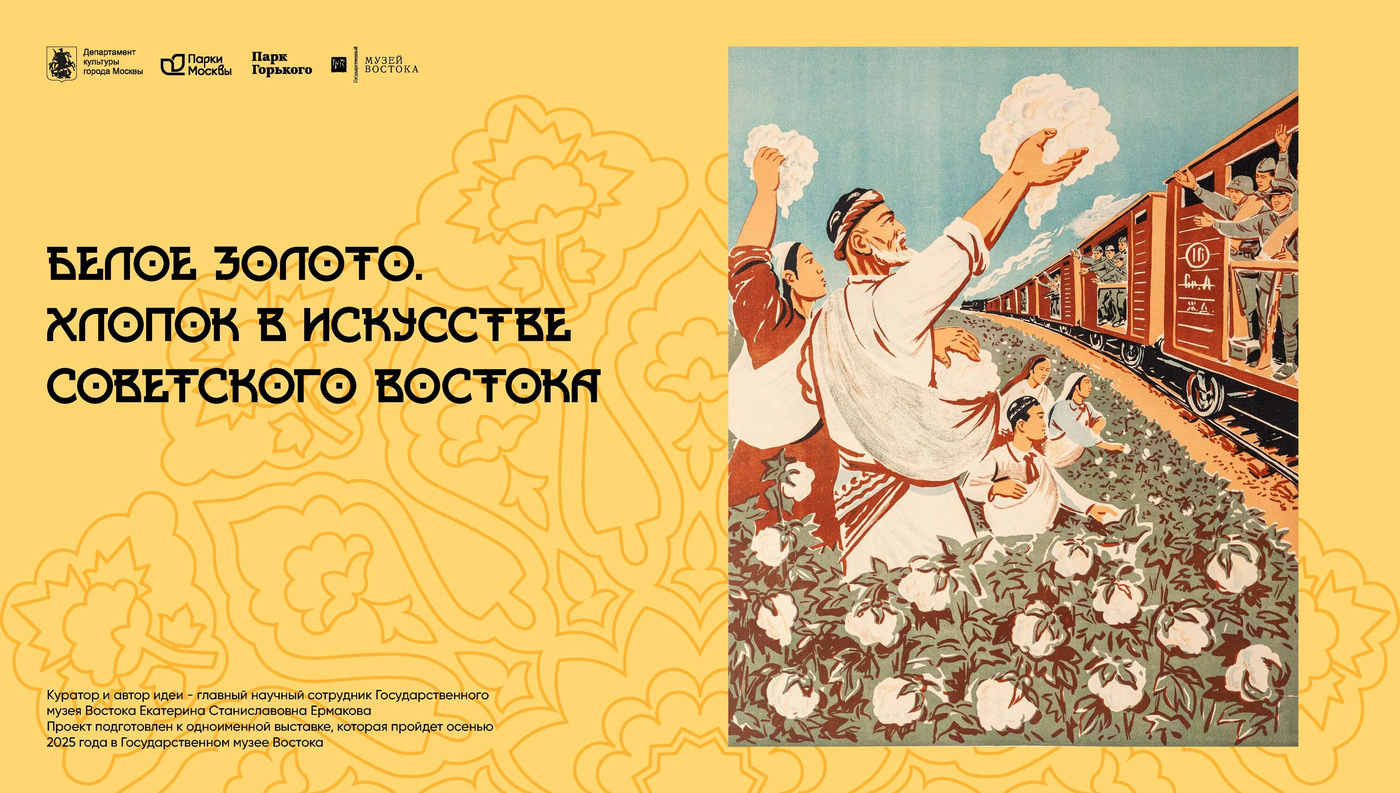The exhibition is dedicated to the grandiose project of cotton farming development and its representation in the art of the former Soviet republics.
Cotton has been cultivated in Central Asia and Transcaucasia since ancient times, where climatic conditions and traditional irrigation systems allowed for its cultivation. Cities such as Samarkand, Urgut, Bukhara, Khujand, and the cities of the Fergana Valley are known for their skilled weavers and fabric production, which was traded along caravan routes to faraway Muscovy. During Soviet times, cotton became a symbol of prosperity in Uzbekistan, Tajikistan, Turkmenistan, Azerbaijan, and other cotton-producing regions. Its image was prominently featured in visual propaganda, representing socialist construction. Since the 1930s, it has been a symbol of progress and development, reflected in a variety of media, including propaganda posters.. Their early samples from the 1920s and 1930s were bilingual or trilingual, with slogans in the national languages written in Arabic or Latin scripts. The cotton theme frequently overlapped with other relevant topics. For instance, satirical images of opponents – bais and mullahs who interfered with cotton-growing efforts – were used: "Every patch of wasteland plowed for cotton is a blow against the bai, the saboteur, and the opportunist!" The image of cotton was promoted not only through mass media propaganda, but also through architectural and environmental design, particularly in the republics that grew cotton. There was no traditional cotton motif in the ornaments of Uzbekistan and Tajikistan; however, it was successfully introduced and integrated into their decorative systems. Cotton boxes appeared on the coats of arms of five of the republics: Uzbekistan, Tajikistan, Turkmenistan, Kyrgyzstan, and Azerbaijan.
A pleiad of prominent artists and painters, who were at the forefront of national fine arts, worked in Uzbekistan. Having received their education in central Russia, they travelled to Turkestan to seek inspiration. Initially, the painters depicted bazaars, tea houses, architecture, and local inhabitants in colourful robes. However, since the 1930s, with cotton becoming a key component of local life, artists shifted their focus to the theme of cotton cultivation. Some artists created brief sketches of cotton pickers, and portraits of foremen and musicians, while others produced monumental paintings commissioned for all-Union exhibitions.
The project has been developed for the exhibition with the same name, which is scheduled to take place in autumn 2025 at the State Museum of Oriental Art.
Cotton has been cultivated in Central Asia and Transcaucasia since ancient times, where climatic conditions and traditional irrigation systems allowed for its cultivation. Cities such as Samarkand, Urgut, Bukhara, Khujand, and the cities of the Fergana Valley are known for their skilled weavers and fabric production, which was traded along caravan routes to faraway Muscovy. During Soviet times, cotton became a symbol of prosperity in Uzbekistan, Tajikistan, Turkmenistan, Azerbaijan, and other cotton-producing regions. Its image was prominently featured in visual propaganda, representing socialist construction. Since the 1930s, it has been a symbol of progress and development, reflected in a variety of media, including propaganda posters.. Their early samples from the 1920s and 1930s were bilingual or trilingual, with slogans in the national languages written in Arabic or Latin scripts. The cotton theme frequently overlapped with other relevant topics. For instance, satirical images of opponents – bais and mullahs who interfered with cotton-growing efforts – were used: "Every patch of wasteland plowed for cotton is a blow against the bai, the saboteur, and the opportunist!" The image of cotton was promoted not only through mass media propaganda, but also through architectural and environmental design, particularly in the republics that grew cotton. There was no traditional cotton motif in the ornaments of Uzbekistan and Tajikistan; however, it was successfully introduced and integrated into their decorative systems. Cotton boxes appeared on the coats of arms of five of the republics: Uzbekistan, Tajikistan, Turkmenistan, Kyrgyzstan, and Azerbaijan.
A pleiad of prominent artists and painters, who were at the forefront of national fine arts, worked in Uzbekistan. Having received their education in central Russia, they travelled to Turkestan to seek inspiration. Initially, the painters depicted bazaars, tea houses, architecture, and local inhabitants in colourful robes. However, since the 1930s, with cotton becoming a key component of local life, artists shifted their focus to the theme of cotton cultivation. Some artists created brief sketches of cotton pickers, and portraits of foremen and musicians, while others produced monumental paintings commissioned for all-Union exhibitions.
The project has been developed for the exhibition with the same name, which is scheduled to take place in autumn 2025 at the State Museum of Oriental Art.
Organizers and participants
The State Museum of Oriental Art , The Central Park of Culture and Leisure named after M. Gorky, The Mardjani Foundation, The Central Park of Culture and Leisure named after M. Gorky / Muzeon Park of Arts
 Mardjani Foundation
Mardjani Foundation







